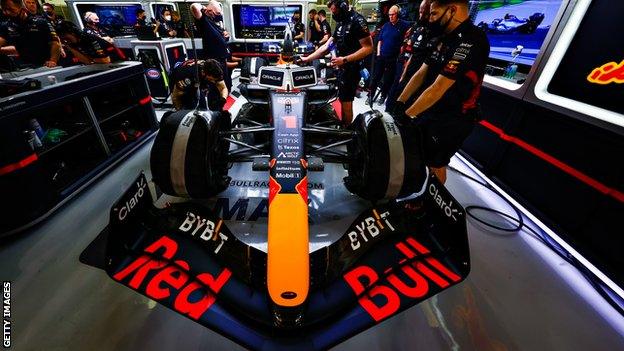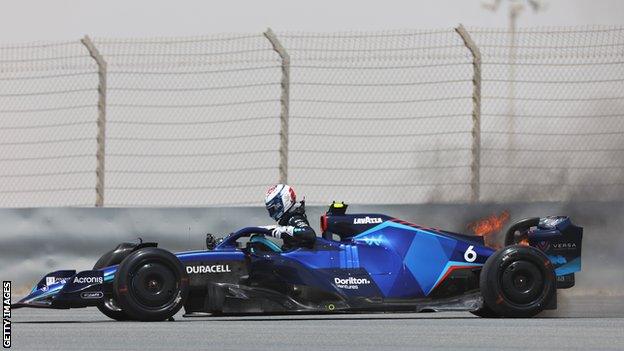Formula 1 testing: If times are hard to read, look for a smirk at Red Bull
- Published

The first race of the Formula 1 season begins next week in Bahrain - live on 5 Live and the BBC Sport website
If you were looking for a vignette to sum up the impression left by Formula 1's final pre-season test, it felt like it came about an hour into the final day.
Red Bull were late out of the garage in Bahrain on Saturday, as they finished fitting upgraded parts to their car. When it finally emerged, it made an immediate impact.
On his first flying lap, Sergio Perez shot straight to the top of the timing sheets. The camera flicked to the Red Bull garage, and caught the company's motorsport adviser Helmut Marko. The Austrian could not hide his delight, his face caught in a smirk of satisfaction that needed no interpretation.
That was just the beginning for Red Bull on Saturday. Perez went faster again before handing the car over to team-mate Max Verstappen. The world champion continued to turn heads in the afternoon and evening session, and ended the day comfortably quickest.
Of course, it's only testing, it doesn't mean anything, no-one knows the specifications in which all the cars were running, and so on. But at Red Bull, they seem not to have got that memo.
Later that afternoon, when Verstappen set the one minute 31.720 seconds lap that put him 0.695 secs faster than second-placed Charles Leclerc's Ferrari, there was a cheer in the Red Bull pit. And another satisfied smile from Marko.
The impression Red Bull made was all the stronger because they tend to fly under the radar in testing.
This doesn't necessarily mean Verstappen and Red Bull will go into the first race of the season in Bahrain next weekend as favourites. But they're certainly among them.
Of their most obvious potential rivals, Ferrari also created a strong impression - they have been quick and consistent from the very start of testing in Spain two weeks ago. Mercedes, meanwhile, seem to be up against it. At least on the face of it, and if their public pronouncements are to be believed.
Red Bull and Ferrari win winter
The Red Bull car made a strong impression from the moment it was unveiled in Spain last month, and even before it emerged in upgraded form on Saturday, the team sounded optimistic.
"It's all very positive," chief engineer Guillaume Rocquelin was quoted as saying in the team's press release on Friday evening. "We were reasonably competitive at the end without even trying."
This remark caught the eye because it was an unusually bullish statement from a senior Red Bull figure mid-way through a test session.
When Perez pulled out of the garage the following morning, the car was sporting new sidepods and a revised floor, and the impression for the rest of the day was that the upgrade had transformed the car.
Quick laps seemed to come easily, and the car looked great out on track, showing none of the aerodynamic bouncing or "porpoising" that has plagued many teams this pre-season - on which more below.
When Verstappen supplanted Leclerc as fastest man towards the end of the day, he did so despite a spin out of the final corner on his first attempt at starting the lap.
His tyres would therefore not have been in optimum condition when he tried again a lap later. But still he beat Leclerc by 0.4secs using the same C4 compound of tyres as the Ferrari had to set its time. The gap extended when Verstappen tried the softest C5 tyres a few minutes later.
Verstappen, as usual, was matter of fact and succinct. "It was just a general progression of the day and just trying a few different tyres," he said. "The car was feeling all right. We went through the programme we planned to do. With the new parts which arrived today, they worked well."
Ferrari, though, also look strong, and have been the team most consistently at the front over six days of running in Spain and the Middle East. Coming off two difficult years, though, their drivers are not taking anything for granted.
"Fast I don't know," Leclerc said. "Reliable it is. This is a good start. It doesn't really mean anything until now. The fact the car is reliable and we can do many, many laps helps us.
"I am pretty sure Red Bull and Mercedes will remain the teams to beat. We are working hard and it looks not bad for now but we have to keep working.
"Mercedes are hiding their gains massively. Red Bull also. They and McLaren are all teams that haven't shown their real performance yet. Neither did we show maximum performance but we don't know how much margin they have."
Are Mercedes struggling?
Over at Mercedes, things did not look so rosy. The car looked a handful on track, and Lewis Hamilton and new team-mate George Russell were adamant that their problems were real.
Before Verstappen ran the revised Red Bull on the final afternoon of testing, Hamilton appeared in the lunchtime official news conference.
Asked if he would be on pole and win the race if the grand prix was to happen now, Hamilton said: "At the moment, no. I'm sure everyone can figure that out - we are not the quickest at the moment. Ferrari look to be the quickest, then perhaps Red Bull, and then maybe us or maybe McLaren, I don't know. But we're currently not at the top."
Did he have concerns about his ability to fight for the title?
"Obviously it's a little bit too early to have those kinds of thoughts," Hamilton said, "but at the moment I don't think we will be competing for wins.
"There is potential within our car to get us there. We just have to learn to be able to extract it and fix some of the problems, which is what we're working on.
"Next week we will get a much better showing of our pace, but I think people will be surprised maybe. Or at least people keep talking about us talking ourselves down. But it's a bit different this year."
People within F1, and fans outside it, will regard these remarks with scepticism, and feel they have been here before.
After all, Mercedes were struggling in pre-season testing last year, too, and Hamilton won the first race, even if he was 0.4secs off Verstappen in qualifying. And there have been previous years that have followed the same script.
That's certainly how Leclerc's team-mate Carlos Sainz viewed it. Speaking before Hamilton had made his remarks, in reference to similar ones from Russell previously, the Spaniard said: "It is typical Mercedes - hype up the others and then come to the first race and blow the competition away.
"If it was the first season they did it, I would maybe believe them, but they have done it for five, six years now and they keep surprising us in the first race.
"So as you can imagine, I don't believe much. Already in GPS we can see what they are doing and, yeah… I am not going to say much."
Sainz was referring to the speed-trace data available to all the teams, and implying that Mercedes were running with their engines down-tuned.
The Mercedes was certainly down on straight-line speed in Bahrain. But it's impossible to tell whether that was due to a lower engine mode, or the car having inherently higher drag, or both. It did not look especially outstanding in the corners, either.
And Hamilton said this was not like last year.
"No it feels a lot different," he said. "It is not as good. I don't think we are going to look as good as we did last year, with the difficult practice and then switch over to the race.
"We have far bigger challenges this time and they are not one-week turnarounds. It will take a little bit longer. From what I'm told, we have a considerable amount of pace to find."

Hamilton said he was unhappy with the nature of his Mercedes
Where do Mercedes' problems lie?
Mercedes' difficulties are rooted in "porpoising". This is a phenomenon new to most people who work in F1 now, but not to the sport as a whole.
It has come about because of the rule changes introduced this season with the aim of making the racing closer and more competitive. These mandate an aerodynamic design philosophy that has not been used in F1 for 40 years.
Instead of flat under-floors, the cars now have shaped tunnels that create downforce using something called 'ground effect'. The faster the air goes through the tunnels under the car, the more downforce it creates and the quicker the car goes around corners.
But this can cause problems on the straights. As the car accelerates, so it gets sucked closer to the ground, and sooner or later it tends to reach a velocity at which the clean, smooth flow becomes disrupted - or stalls - causing a sudden loss of downforce.
The load on the car suddenly reduced, the rear shoots - or bounces - up, whereupon the airflow smooths out again and sucks the car back down until it stalls once more and so on.
This leads to a high-frequency bouncing, which became known back in the late 1970s and early 80s - when ground effect was last permitted in F1 - as porpoising. That is because the car tends to rock from back to front, like a porpoise leaping out of the ocean.
Porpoising is easy to solve - the team can just raise the ride height. But that makes the car slower because it takes it away from the set-up with which it has most performance. The trick is to find a way to run the car as close as possible to its optimum set-up window, without instigating the porpoising.
It is this trade-off that Mercedes have not yet found, and it is also what is making reading testing harder this year than for as long as most can remember.
Added to the usual unknowns of fuel load, engine mode and so on, there is now another - where are the team on their porpoising set-up compromise, and therefore how much theoretical performance is there still to find if they can get more on top of it?
All teams have been suffering with porpoising to some extent or another. At the front of the field, Red Bull and Ferrari seem to have a better handle on it than Mercedes.
The Red Bull hardly seemed to porpoise at all on Saturday. The Ferrari did a bit, but to nowhere the same extent as the Mercedes.
"I don't think they're exceptional," Russell said. "I think we're probably not as competitive as we'd like. The Ferrari and Red Bull are in the sort of natural position - their delta to the midfield and back is probably correct.
"It is pretty clear where we're limited. You only have to watch the videos and you see the car bouncing around a lot.
"We have yet to find a solution, but this is a long game. I do believe the performance is there somewhere. We just have to find it."

What about the rest?
McLaren ended the first test with many predicting they were in for a good season. They appeared to have closed the gap to the front and looked among the most competitive teams.
But things did not go so well in Bahrain. In the higher temperatures in the desert, the car was cooking its front brakes, and over three days the team did not find a solution, despite flying in new parts. More new parts will be made in time for the race.
Overall, the field seems to have closed up a fair bit and it's anyone's guess how the teams will spill out when the going gets serious, with Alpine, Alpha Tauri, Alfa Romeo and even Haas all setting some quick times, for what it's worth.
This is a new era of F1. All the teams and drivers have been talking about how, as a result, the development curves of the teams will be steep. Being fast in Bahrain is no guarantee of staying that way over 22 or 23 races.
Best lap times by each team in Bahrain
Red Bull (Max Verstappen) 1:31.720 C5 tyre
Ferrari (Charles Leclerc) 1:32.415 C4
Alpine (Fernando Alonso) 1:32.698 C5
Mercedes (George Russell) 1:32.759 C4
Alfa Romeo (Valtteri Bottas) 1:32.985 C3
Alpha Tauri (Yuki Tsunoda) 1:33.002 C4
Haas (Mick Schumacher) 1:33.151 C3 *
McLaren (Lando Norris) 1:33.191 C3
Aston Martin (Sebastian Vettel) 1:33.821 C4
Williams (Alex Albon) 1:35.171 C3
* Schumacher set a 1:32.241 in extra running allocated to his team because of freight delays, held in faster conditions at the end of the final day
C5 tyre is softest and theoretically fastest over one lap, C1 hardest
